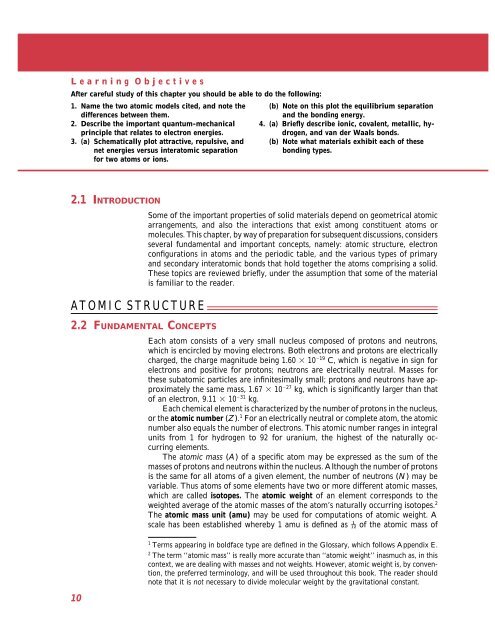Chapter 2 / Atomic Structure and Interatomic Bonding
Chapter 2 / Atomic Structure and Interatomic Bonding
Chapter 2 / Atomic Structure and Interatomic Bonding
Create successful ePaper yourself
Turn your PDF publications into a flip-book with our unique Google optimized e-Paper software.
Learning Objectives<br />
After careful study of this chapter you should be able to do the following:<br />
1. Name the two atomic models cited, <strong>and</strong> note the<br />
differences between them.<br />
2. Describe the important quantum-mechanical<br />
principle that relates to electron energies.<br />
3. (a) Schematically plot attractive, repulsive, <strong>and</strong><br />
net energies versus interatomic separation<br />
for two atoms or ions.<br />
2.1 INTRODUCTION<br />
ATOMIC STRUCTURE<br />
2.2 FUNDAMENTAL CONCEPTS<br />
10<br />
(b) Note on this plot the equilibrium separation<br />
<strong>and</strong> the bonding energy.<br />
4. (a) Briefly describe ionic, covalent, metallic, hydrogen,<br />
<strong>and</strong> van der Waals bonds.<br />
(b) Note what materials exhibit each of these<br />
bonding types.<br />
Some of the important properties of solid materials depend on geometrical atomic<br />
arrangements, <strong>and</strong> also the interactions that exist among constituent atoms or<br />
molecules. This chapter, by way of preparation for subsequent discussions, considers<br />
several fundamental <strong>and</strong> important concepts, namely: atomic structure, electron<br />
configurations in atoms <strong>and</strong> the periodic table, <strong>and</strong> the various types of primary<br />
<strong>and</strong> secondary interatomic bonds that hold together the atoms comprising a solid.<br />
These topics are reviewed briefly, under the assumption that some of the material<br />
is familiar to the reader.<br />
Each atom consists of a very small nucleus composed of protons <strong>and</strong> neutrons,<br />
which is encircled by moving electrons. Both electrons <strong>and</strong> protons are electrically<br />
charged, the charge magnitude being 1.60 10 19 C, which is negative in sign for<br />
electrons <strong>and</strong> positive for protons; neutrons are electrically neutral. Masses for<br />
these subatomic particles are infinitesimally small; protons <strong>and</strong> neutrons have approximately<br />
the same mass, 1.67 10 27 kg, which is significantly larger than that<br />
of an electron, 9.11 10 31 kg.<br />
Each chemical element is characterized by the number of protons in the nucleus,<br />
or the atomic number (Z). 1 For an electrically neutral or complete atom, the atomic<br />
number also equals the number of electrons. This atomic number ranges in integral<br />
units from 1 for hydrogen to 92 for uranium, the highest of the naturally occurring<br />
elements.<br />
The atomic mass (A) of a specific atom may be expressed as the sum of the<br />
masses of protons <strong>and</strong> neutrons within the nucleus. Although the number of protons<br />
is the same for all atoms of a given element, the number of neutrons (N) may be<br />
variable. Thus atoms of some elements have two or more different atomic masses,<br />
which are called isotopes. The atomic weight of an element corresponds to the<br />
weighted average of the atomic masses of the atom’s naturally occurring isotopes. 2<br />
The atomic mass unit (amu) may be used for computations of atomic weight. A<br />
scale has been established whereby 1 amu is defined as of the atomic mass of<br />
1 Terms appearing in boldface type are defined in the Glossary, which follows Appendix E.<br />
2 The term ‘‘atomic mass’’ is really more accurate than ‘‘atomic weight’’ inasmuch as, in this<br />
context, we are dealing with masses <strong>and</strong> not weights. However, atomic weight is, by convention,<br />
the preferred terminology, <strong>and</strong> will be used throughout this book. The reader should<br />
note that it is not necessary to divide molecular weight by the gravitational constant.



